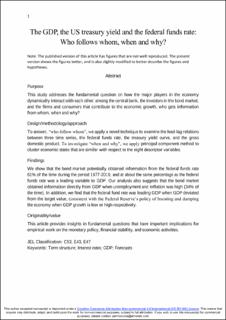| dc.contributor.author | Seip, Knut Lehre | |
| dc.contributor.author | Zhang, Dan | |
| dc.coverage.spatial | United States of America | en_US |
| dc.date.accessioned | 2021-09-30T11:34:03Z | |
| dc.date.available | 2021-09-30T11:34:03Z | |
| dc.date.created | 2021-05-06T14:22:37Z | |
| dc.date.issued | 2021-06-08 | |
| dc.identifier.issn | 1757-6385 | |
| dc.identifier.uri | https://hdl.handle.net/11250/2786613 | |
| dc.description.abstract | Purpose: This study addresses the fundamental question on how the major players in the economy
dynamically interact with each other: among the central bank, the investors in the bond market, and the firms and consumers that contribute to the economic growth, who gets information from whom, when and why? Design/methodology/approach: To answer, “who follow whom”, we apply a novel technique to examine the lead-lag relations between three time series, the federal funds rate, the treasury yield curve, and the gross domestic product. To investigate “when and why”, we apply principal component method to cluster economic states that are similar with respect to the eight descriptor variables. Findings: We show that the bond market potentially obtained information from the federal funds rate 61% of the time during the period 1977-2019, and at about the same percentage as the federal funds rate was a leading variable to GDP. Our analysis also suggests that the bond market obtained information directly from GDP when unemployment and inflation was high (34% of the time). In addition, we find that the federal fund rate was leading GDP when GDP deviated from the target value, consistent with the Federal Reserve’s policy of boosting and damping the economy when GDP growth is low or high respectively. Originality/value: This article provides insights in fundamental questions that have important implications for empirical work on the monetary policy, financial stability, and economic activities. | en_US |
| dc.language.iso | eng | en_US |
| dc.publisher | Emerald | en_US |
| dc.relation.ispartofseries | Journal of Financial Economic Policy; | |
| dc.rights | Navngivelse-Ikkekommersiell 4.0 Internasjonal | * |
| dc.rights.uri | http://creativecommons.org/licenses/by-nc/4.0/deed.no | * |
| dc.subject | Term structures | en_US |
| dc.subject | Interest rates | en_US |
| dc.subject | Gross domestic product | en_US |
| dc.subject | Forecasts | en_US |
| dc.subject | Financial markets | en_US |
| dc.subject | Macroeconomy | en_US |
| dc.subject | Central bank policies | en_US |
| dc.title | The GDP, the US treasury yield and the federal funds rate: Who follows whom, when and why? | en_US |
| dc.type | Peer reviewed | en_US |
| dc.type | Journal article | en_US |
| dc.description.version | acceptedVersion | en_US |
| cristin.ispublished | true | |
| cristin.fulltext | preprint | |
| cristin.fulltext | postprint | |
| cristin.qualitycode | 1 | |
| dc.identifier.doi | 10.1108/JFEP-11-2020-0241 | |
| dc.identifier.doi | https://doi.org/10.1108/JFEP-11-2020-0241 | |
| dc.identifier.cristin | 1908565 | |
| dc.source.journal | Journal of Financial Economic Policy | en_US |
| dc.source.pagenumber | 1-21 | en_US |

